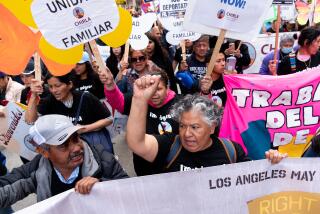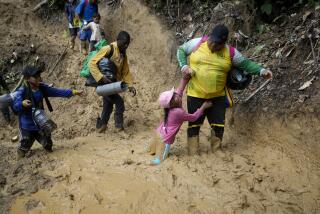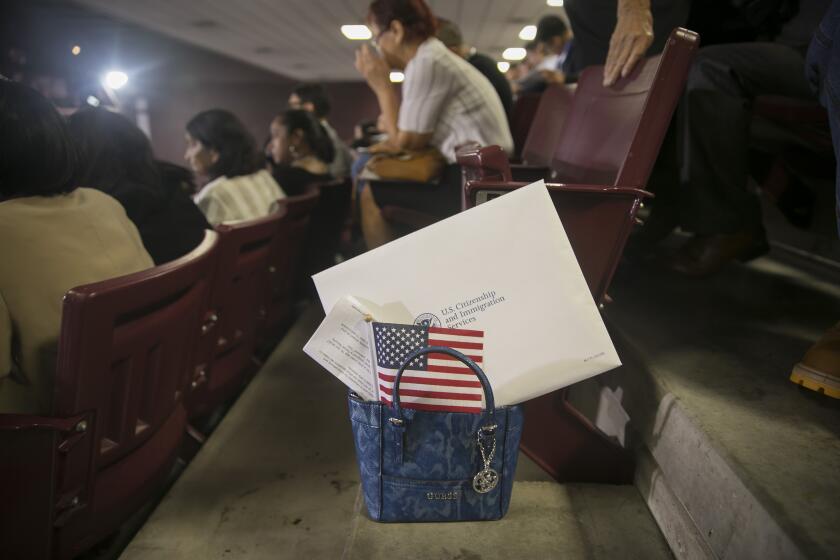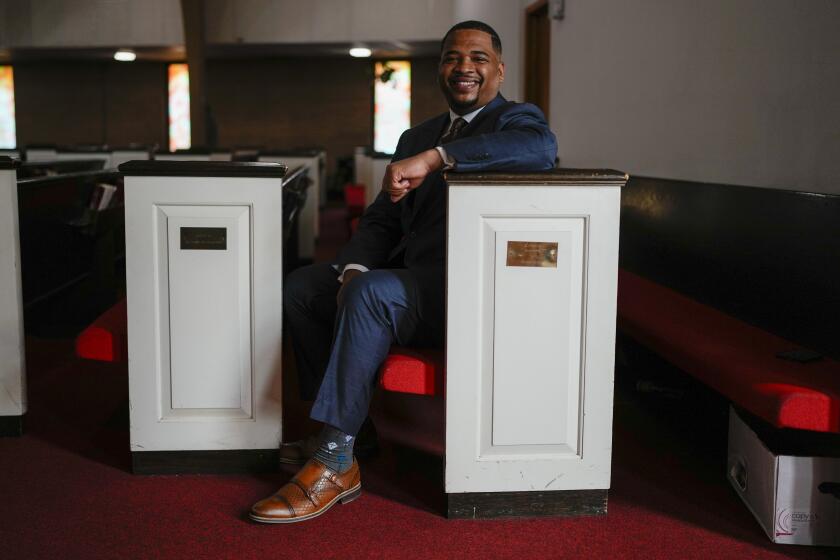Trump is stripping immigrant children of protections, critics say. Supporters say he’s closing loopholes
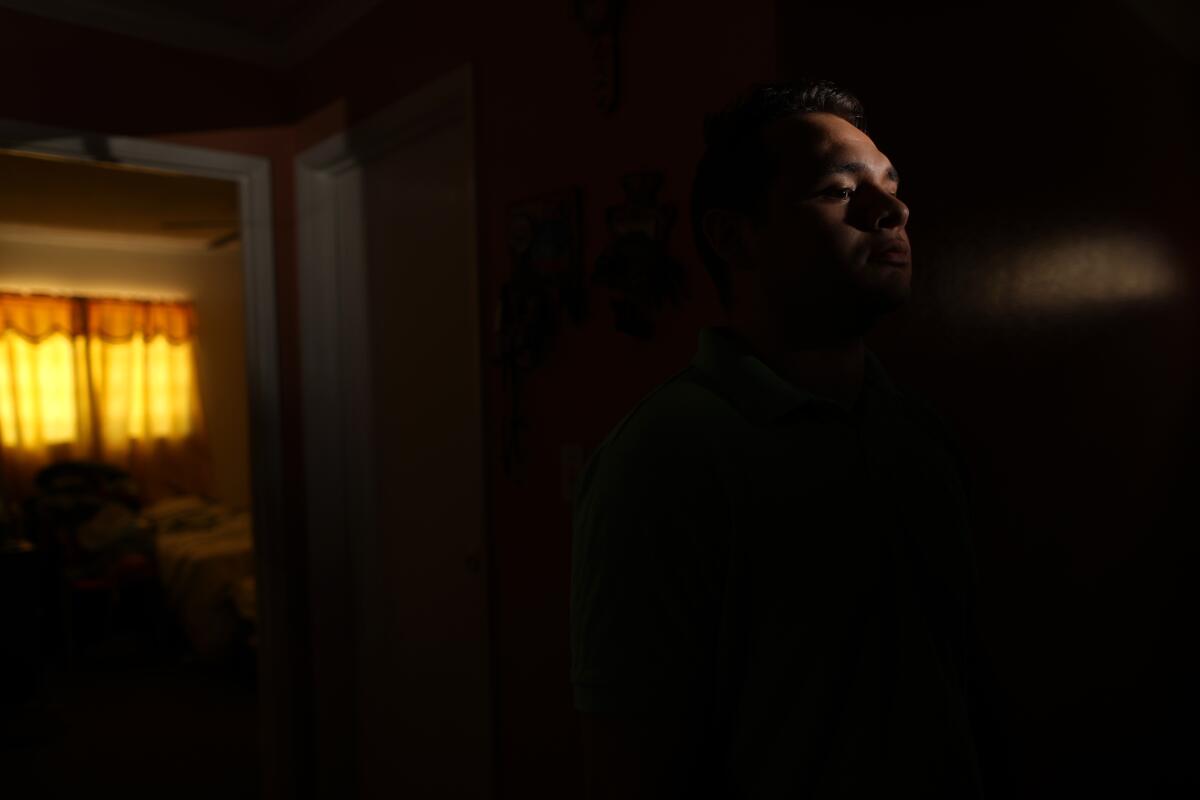
In the nearly four years since Alexis arrived alone in the United States as a 17-year-old from El Salvador, he has been granted asylum, learned English, secured a job at a bakery and studied for his upcoming driver’s license exam. This month he’ll file an application for permanent residency.
Now 21, Alexis feared being targeted by gangs in El Salvador that had beat up his sister and killed boys in his neighborhood for refusing to join. Living with his aunt and uncle in South Los Angeles, Alexis finally feels safe.
None of that would have been possible if Alexis were applying for asylum now. Recent significant changes by the Trump administration to asylum policy for children who arrived in the U.S. without a parent or legal guardian mean that he wouldn’t qualify.
“When I decided to come to the United States, that was a risk of my life,” he said. “They should help us more than they are trying to right now. We are humans as well. We have rights.”
The policy shift is among the latest in a string of reversals by the administration in protections for immigrant children, who have been the most prominent collateral damage in its crackdown on migrants at the southern border.
As the overarching flow of migration has gradually shifted from mostly single men coming from Mexico to entire families coming from Central America, images of children being torn from their parents and held in cages have shocked the world and outraged not only immigrant rights groups and progressive voters but also many who otherwise back Trump’s policies.
Administration supporters argue that child migrants often are used, both by family members and strangers, in an exploitative way as cover for illegal activity. David Inserra, immigration policy analyst at the conservative Heritage Foundation, said the challenge is how to make humanitarian programs like asylum help persecuted people but prevent others from abusing the help.
Too many loopholes incentivize people to bring or send their children to the U.S., Inserra said. He said the 1997 Flores Act, which limited the amount of time that children can be held in captivity, and the 2000 Trafficking Victims Protection Act, which allows unaccompanied children to seek asylum in an interview with a trained asylum officer, had unintended consequences that the administration is trying to address, despite Congress’ inability to enact necessary reforms.
“I think we all want to protect children, to make sure that they’re treated well,” Inserra said. “But I think we also need to do everything in our power to make sure there aren’t as many children coming to our border.”
The changes to asylum for unaccompanied children come as the federal government struggles with the arrival of thousands of Central Americans at the southern border. With more than 760,000 people apprehended by Border Patrol as of July — already a 92% increase over last year, with two months left in fiscal 2019 — immigration authorities say they’re overwhelmed. Monthly totals have decreased significantly since May, which DHS credits to stepped-up enforcement by the governments of Mexico and Guatemala.
Trump’s new policy on unaccompanied minors is an extension of his strategy to make asylum more difficult for practically anyone to obtain. The administration adopted a controversial policy last month forcing thousands of asylum seekers — including children — to live in Mexico while waiting for immigration court hearings. Last month, a federal judge in California temporarily blocked a broader rule that rendered asylum seekers at the U.S. border ineligible for protection if they passed through any other country and did not make claims there.
Under the Trafficking Victims Protection Reauthorization Act, most recently reauthorized in 2013, children also are not subject to the one-year filing deadline for adult asylum seekers. The new policy makes it far easier to strip young migrants of their “unaccompanied” status, which affords them a measure of legal protection, making them more likely to be deported.
It requires asylum officers with U.S. Citizenship and Immigration Services to reestablish that an applicant who was previously determined to be unaccompanied continued as such when filing for asylum. Applicants who file after they turn 18 or after they reunite with a parent or legal guardian must now raise their claims in immigration court.
The policy applies to all USCIS decisions after June 30. Anyone affected by the new policy who filed for asylum after being in the U.S. for more than a year is now ineligible.
Last month, lawyers with Public Counsel, Kids in Need of Defense (KIND), the Catholic Legal Immigration Network and the law firm Goodwin Procter sued to block the Trump administration from continuing to enforce the new policy, alleging that it violates the Constitution and the trafficking victims protection act. Lawyers said they’d already heard of numerous asylum denials based on the policy.
Earlier this month, a U.S. district judge in Maryland temporarily halted the policy from continuing and ordered the government to “retract any adverse decision already rendered in an individual case” under the new rules and reinstate the previous rules for asylum seekers.
KIND President Wendy Young said that advocates spent decades building protections into law that accommodate the needs and vulnerabilities of immigrant children.
“What’s taken us 15 years to build is taking them two years to tear down,” she said. “Now we’re in a completely different political landscape, where they’re trying to pull us backward in time and treat these children like adults again.”
Even so, Young said that the public outrage over the family separation policy last summer gave her hope.
“That was a strong reminder that people still care,” she said. “Particularly when these measures impact children, it awakens something in us as people.”
Scott Shuchart, legal strategy director at KIND, said that processing a child’s asylum claim poses a number of challenges beyond those facing adults. Trauma could impair a young person’s ability to promptly file for asylum, he said. And it could be weeks before they’re released from government custody and their sponsor or family finds a lawyer.
After clearing those hurdles, the child could require therapy before they’re ready to address what happened to them.
“There are reasons you do things different for children,” said Shuchart, a former DHS official who resigned last year over the administration’s migrant family separation policy. “They are dependent on an adult being available and competent enough to do things for them.”
A spokeswoman said it is USCIS policy not to comment on pending litigation. But in a previous interview with The Times, spokeswoman Jessica Collins said that “Congress must reform the law to address the underlying issues fueling the border crisis and encouraging unaccompanied minors to make the dangerous journey to the United States.”
Other attempts by the administration to challenge the laws governing the treatment of migrant children have led to intense court fights.
Last week, the Trump administration announced it is rolling out new regulations that would allow the government to indefinitely hold minors and families with children by relaxing the licensing requirements of facilities in which children can be detained. Advocates already had sought to block the regulations when the administration first proposed them last September. Lawsuits are expected immediately.
The government blamed its family separation policy — which resulted in an outpouring of public anger and media criticism after thousands of children were removed from their parents — on the so-called Flores settlement. The administration argues that the settlement puts it in a bind because no existing family detention centers meet the restrictive requirements for the treatment of minors, which forces authorities to release children while keeping their parents in custody.
Acting Homeland Security Secretary Kevin McAleenan said Wednesday that the settlement is the driving factor of Central American families coming to the U.S. border.
Last month, a panel of three U.S. district judges in San Francisco upheld a 2017 ruling that immigration authorities must provide children detained at the border with adequate food, water, bedding, toothbrushes and soap.
Another bitterly divisive child-migrant policy was Trump’s move during his first year in office to end Deferred Action for Childhood Arrivals, which provides immigrants as young as 15 with temporary protection from deportation. In response to lawsuits, two U.S. district courts halted the program’s termination and required USCIS to continue accepting renewal applications from DACA recipients while the lawsuits continue. Last month, the Supreme Court said it will take up the case.
In 2017, the administration abruptly ended the Central American Minors program, which allowed immigrants who were lawfully present in the U.S. to apply for refugee status or humanitarian parole on behalf of their children younger than 21, as well as for their spouses and grandchildren living in El Salvador, Guatemala or Honduras. In announcing the termination, DHS said the “discretionary change in policy” doesn’t prevent those people from otherwise applying for temporary parole, which is generally issued on a case-by-case basis for urgent humanitarian reasons.
After advocates sued, a federal judge ordered the government to continue processing applications for more than 2,700 people who had already been approved by USCIS to relocate to the U.S. and were left in limbo.
Changes early last year to yet another program, called special immigrant juvenile status, affected young immigrants who were abused, abandoned or neglected by a parent. The classification, available by law to immigrants under age 21, allowed them to embark on a path to U.S. citizenship. The administration started rejecting applications from immigrants over age 18, saying it is adhering to laws in most states that set adulthood at age 18.
Advocates in California, Washington, New Jersey and New York sued over the denials. In California, a federal judge temporarily banned the government from trying to deport any applicants while the lawsuit continues.
John Sandweg, former acting director of USCIS and acting general counsel of DHS under President Obama, said that stripping children of protections doesn’t deter people from coming. Sandweg said it could take ICE and Customs and Border Protection decades to recover from the negative reputation that the agencies have been hit with as a result of this administration’s policies. He said it has hurt recruiting, morale and the agencies’ ability to work with local law enforcement.
Sandweg said existing protections “were put in place for good reason.”
“When the numbers are elevated like they are right now, I think the need to have these safeguards is even more acute,” he added. “There’s just more opportunity to have harm come a child’s way.”
Many other countries have laws in place to protect migrant children. In Canada, for instance, children are detained “only as a measure of last resort.” In Italy, children are appointed voluntary guardians who support them with legal paperwork and other needs.
Numbers of arriving unaccompanied children reached a peak of 59,000 in fiscal year 2016, according to the Office of Refugee Resettlement. Between October and July, 55,000 unaccompanied children were released from ORR care, more than a third of them age 17. Nearly half of those children went home with a parent or legal guardian.
Mark Greenberg, a senior fellow at the Migration Policy Institute, a nonpartisan, liberal-leaning Washington think tank, said that there’s always been some ambiguity around the definition of an unaccompanied child. By law, unaccompanied children are under age 18, have no legal status, and no parent or legal guardian available in the U.S. to care for them.
Greenberg worked for the Administration for Children and Families in the Department of Health and Human Services, which oversees ORR, until 2017. He said leaders would sometimes question whether children who arrived at the border alone but reunited with parents should be regarded as unaccompanied. But he said the conversation always fizzled quickly.
“We very much saw the mission of the program as being to provide services and supports to arriving children and to help them get to their families,” he said.

Many child migrants arriving in the future won’t be afforded the same consideration.
Alexis turned 18 a week after he arrived at the Texas border. Once he was released to the care of his aunt and uncle, he went down a list of pro bono immigration lawyers given to him at the shelter where he’d been processed. Public Counsel agreed to represent him.
When he appeared at immigration court to deliver a letter that his lawyers had written, the setting — adults in suits and a judge in a robe — made him nervous. He worried he’d say something wrong, even though he wasn’t on trial.
Later, sitting before an asylum officer, he felt much more at ease. The officer spoke Spanish and talked to him in a soft, friendly voice.
When Alexis received notice that his asylum petition had been approved, he wept for joy, he said. He plans to enroll in community college and hopes to one day become a nurse.
“It’s really sad to know that others won’t have the opportunity I had,” he said.
More to Read
Start your day right
Sign up for Essential California for news, features and recommendations from the L.A. Times and beyond in your inbox six days a week.
You may occasionally receive promotional content from the Los Angeles Times.

